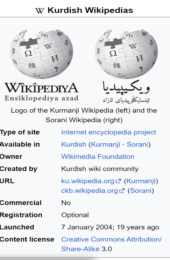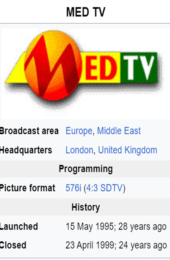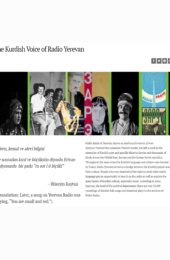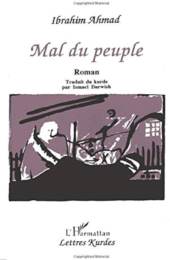Kurdish Wikipedia
Kurdish Wikipedia (Kurmanji Kurdish: Wîkîpediya kurdî, Sorani Kurdish: ویکیپیدیای کوردی) refers to two Wikipedia editions which are written in two forms of Kurdish language; Kurmanji and Sorani.
The original one was founded in January 2004. As of December 2023, the Kurmanji Wikipedia has 73,702 articles and Sorani Wikipedia has 52,794 articles.[1] There are also two other Wikipedia editions for Zazaki and Southern Kurdish with the latter still in the test phase.
History
The Kurdish Wikipedia established on January 7, 2004,[2] designed to contain articles in Kurmanji and Sorani at the same time. On August 12, 2009, Kurdish Wikipedia separated into two versions due to technical and linguistic issues. The old version (ku.) remained as Kurmanji Kurdish Wikipedia and a new version (ckb.) created for Sorani Kurdish Wikipedia.
See also
MED TV
MED TV was the first Kurdish satellite TV[1] with studios in London, England and Denderleeuw, Belgium. MED TV broadcast programs mainly in six languages, Kurdish (Sorani, Kurmanji, and Zaza dialects), English, Arabic, Assyrian and Turkish.
Programs and audience
MED TV Programmes were a varied mix from children's programs, music, documentaries and news broadcasts.[2] A program in which Kurdish books written in the three scripts of Arabic, Kyrillic and Latin were discussed, was moderated by a journalist of Özgür Gündem.[2] It broadcast to Europe, North Africa and the Middle East. Its primary audience was in the Middle East where it was seen by many as a refreshing source of information outside of state censorship. It also has a large audience amongst the Kurdish population scattered throughout Europe.[citation needed] In Turkey, it was forbidden to watch Med TV, people were arrested for having been caught watching its programs. The police would search for satellite dishs in Diyarbakır, which they'd confiscate.[2] Turkey saw MED TV as a part of the Kurdistan Workers' Party (PKK),[3] which it classifies as a terrorist organization. Nonetheless its shows were very popular amongst Kurds in Turkey.[4]
Organization
At its establishment in 1995, thirteen media workers employed at the Television. Most were amateurs, only one had an education in the field. The company expanded its activities significantly until in 1997, the television counted with 250 employees.[2] The TV had close ties with the newspaper Özgür Gündem, whose chief-editor Gurbetelli Ersöz was also MED TVs chief-editor for Turkish Kurdistan.[2]
Rûdaw
Rudaw Media Network (Kurdish: تۆڕی میدیاییی ڕووداو, romanized: Tora Medyayî ya Rûdaw), is a major media broadcaster in the Kurdistan Region, Iraq.[2][3][4]
Rudaw Media Network, headquartered in Erbil, the capital of Iraq's Kurdistan Region, operates as a global media powerhouse with correspondents strategically positioned across the Middle East, Europe, and the United States.
This multi-faceted media outlet delivers content in various languages, including English, Kurdish, Arabic, and Turkish.[5]
History
Rudaw Media Network originated as a weekly print newspaper distributed in the Kurdistan Region and Europe, the network initially garnered international attention through its European edition, catering to the burgeoning diaspora communities of that era. In a noteworthy commitment to environmental sustainability, Rudaw transitioned from print to a fully digital format, discontinuing its newspaper publication.
The network's diverse portfolio includes a weekly newspaper in the Sorani dialect, boasting a circulation of 3,000, a Kurmanji version circulated in Europe, a comprehensive website available in Kurdish, English, Arabic, and Turkish, and a satellite TV station. Rudaw Media Network is funded and supported by Rudaw Company, with a primary mission to disseminate news and information concerning Kurdistan and the broader Middle East region.
In the present day, Rudaw Media Network has expanded its reach to include a radio news channel broadcasting on shortwave throughout the Middle East. Furthermore, its live stream is accessible to global audiences online. Notably, in 2023, the network introduced its podcast portal, featuring a diverse array of podcasts spanning topics such as culture, news, politics, economics, and technology.
Zarok TV
Zarok TV (English: Kid TV[1]) is the first Kurdish satellite television station in Turkey for Kurdish children, broadcasting since 21 March 2015, based in Diyarbakır (Amed). The channel broadcasts programs in various Kurdish languages, specifically Kurmanji, being the most widely spoken Kurdish dialect in Turkey, Zazaki and some Sorani.[2][3]
Accused of “separatist and subversive” activities, it was shut down on 29 September 2016 under the emergency statutory decree issued during the aftermath of 15 July's failed coup d'état, alongside 12 other television and 11 radio stations, when the police raided the television station's headquarters.[4][5][6][7][8] Zarok TV's director, said there were no warning before the closure.[9]
In November 2016 the TV station was allowed to broadcast again after much criticism for the sudden closure. The European Parliament condemned the Turkish authorities stating “misusing” law in the aftermath of the unsuccessful coup attempt. Owner of Zarok TV and also several other cultural Kurdish TV channels, estimated the company had lost “125-150 thousand dollars” in October due to closures.[10]
The Kurdish Voice of Radio Yerevan
Public Radio of Yerevan, known as Radyoya Erîvané or Erivan Radyosu* beyond the Armenian-Turkish border, has left a mark in the memories of Kurdish poet and guerilla Hüseyin Kaytan and thousands of Kurds across the Middle East, Europe and the former Soviet republics. Throughout the years when the Kurdish language and culture were banned in Turkey, Radio Yerevan served as a bridge between the Kurdish people and their culture. People who were deprived of the right to study their native language got an opportunity to hear it on the radio as well as explore the many layers of Kurdish culture, especially music. According to Artur Ispiryan, the head of the archival department, there are over 10,000 recordings of Kurdish folk songs and theatrical plays in the archives of Public Radio.
Riya Teze (rojname)
Rya Teze ('New Path'), formerly written as Rja Ţəzə and Р’йа т'әзә (in Cyrillic script), was a Kurdish language newspaper published from Yerevan, Armenia.[1][2] The newspaper was founded in March 1930 and the first issue was published on 25th March 1930, printed in Kurmanji Kurdish with the newly latinised alphabet of Shemo-Margulov.[2][3][4] It was the organ of the Kurdish section of the Communist Party of Armenia,[1] and was produced under the auspices of the Central Committee of the Communist Party of Armenia and the Supreme Council and the Council of Ministers of the Armenian SSR. At the time, it was a four-page newspaper, published twice every week and with a circulation of 600 copies.[4] Prior to the Kurdish linguist and author Cerdoyê Genco taking over as editor in 1934, the newspaper was run by three Armenians born in Western Armenia: Kevork Paris, Hrachya Kochar and Harutyun Mkrtchyan, who knew Kurdish.[4][5] Publication was discontinued in 1937.[2]
In 1955 publication of Rya Teze (in Cyrillic script) was resumed with Miroyi Asad as its editor.[2][6] As of the early 1970s it was published semiweekly and had a circulation of 2,800.[6] By 1976 circulation reached 5,000.[3]
As of the 1980s Rya Teze had a weekly circulation of 4,000 and was read by Kurds across the Soviet Union;[2] a smaller number of readers existed among the Kurds in Europe, who sometimes adopted material from it in their own publications published in Germany and Sweden.[7] In 1989 Tital Muradov took over as editor, and in 1991 the editorship was handed over to Emirike Serdar.[2]
Following the disintegration of the Soviet Union the newspaper faced financial difficulties as it no longer received state support. It survived, however. It was converted into a monthly with a circulation of five hundred. In 2000 the script was changed back to Latin alphabet.[2] The newspaper was shut down in 2003 due to economic problems. All in all 4,800 issues of Rya Teze were published between 1930 and 2003.[2]
Nûbihar
Nûbihar also known as Kent Işıkları (Kurdish: Weşanxane Nûbihar, Turkish: Nubihar Yayınları) is an academic publisher founded in March 1992 in Istanbul, Turkey. The publishing house specialises on topics pertaining to Kurds.[1]
The publication is named after a work of Ehmedê Xanî.[2]
History
Nûbihar was founded as a Nursi-influenced publication house just after the ban on the Kurdish was lifted. Even though it was legal to publish in Kurdish, its work remained a high-risk activity as local officials were ready to stifle Kurdish cultural activities by any chance. Nonetheless, Nûbihar survived any closure arguably because its publications were of religious and cultural nature and not political.[3] During this period, the publication was accused of being Kurdist by the Gülen movement after the former had criticised the censorship of words like "Kurds" and "Kurdistan" in their publications of the works of Said Nursî.[4]
Gelawêj
Evil of the people
The evil of the people is the suffering, the hope of an entire
people: the Kurds.
Suffering equal to that of the young and beautiful Kalée,
alone, about to give birth. Hope equal to that of Jwamer,
who was sent to prison for ten years by fate because
he found himself, by chance, at the head of a demonstration.
Evil of the people is a torn Kurdistan, with a feeling
of survival of the things of the earth and the soul. He
denounces the attacks on human dignity of which different
regimes and their prisons remain forever guilty.
Despite this, the book remains a novel. Ibrahim Ahmad
incorporates elements that are non-fictional in nature into
stories that remain captivating for the imagination and
sensitivity; his heroes experience the illumination of
the “feeling of existence”.
Ibrahim Ahmad is not only a femon, but also an actor,
sometimes hidden, sometimes discovered, in the great dramas
in Kurdistan,
Ibrahim AHMAD. Born in 1913 in Soulémani, Iraqi
Kurdistan. Founder of the famous linear magazine Gelawej (1939-1949),
he participated in the development of Kurdish literature.
Novelist, poet but also short story writer, Ahmad is considered the
representative of the realistic movement in contemporary Kurdish
literature.
Ismael DARWISH. Born in 1961 in Kirkuk, Kurdistan.
Iraqi. Among the unpublished texts of contemporary Kurdish literature,
he translated a collection of poems and several Kurdish short
stories.
Work translated with the assistance of the Cenure National du Livre.
Hawar
Hawar (meaning The Cry in English) was a Kurdish literature magazine, which was published in Damascus between 1932 and 1943.[1] The magazine was first issued by Celadet Alî Bedirxan[1] on 15 May 1932. The magazine was the first Kurdish literary magazine in Syria[2] and it was intended to publish it on a monthly basis,[2] but its publication was interrupted several times. The first 23 issues were published between 15 May 1932 and the 27 September 1935.[3] The issues number 24 - 26 appeared between 1 April 1934 and 18 August 1935.[3] The remainder was published between April 1941 and August 1943,[3] and the French, who governed Syria and Lebanon at the time, supported its publication.[4] The 57th and last issue was released on 15 August 1943.[5] The first 23 issues of the magazine were published in both the Latin and the Arabic alphabets, but from the 24th issue onward, only the Latin alphabet was used.[3] The Kurdish alphabet, which was formulated by the publisher Celadet Alî Bedirxan and also referred to as Hawar alphabet or the Bedirxan alphabet, was used to publish Hawar.[6] The texts which were published emphasized the value of the Kurdish folklore for developing the Kurdish language and personal qualities.[7] Hawar had its most subscribers in Syria and Iraq, but also Lebanon, Iran. Some educational institutions and libraries in Europe and the Middle East also subscribed to the Hawar magazine.[8] Since 2006, the 15 May, the date of the first publication of Hawar in 1932, is celebrated as the Kurdish language day.[9][10]
Celadet Alî Bedirxan said of his purpose for the magazine: "Hawar is the voice of knowledge. Knowledge leads to personal reflection. A person who becomes aware of the inner-self desires freedom and happiness. Self-knowledge also leads to self-expression. This magazine will reflect those expressions in the Kurdish language".[2]








